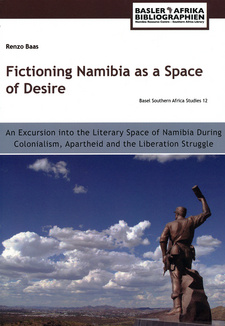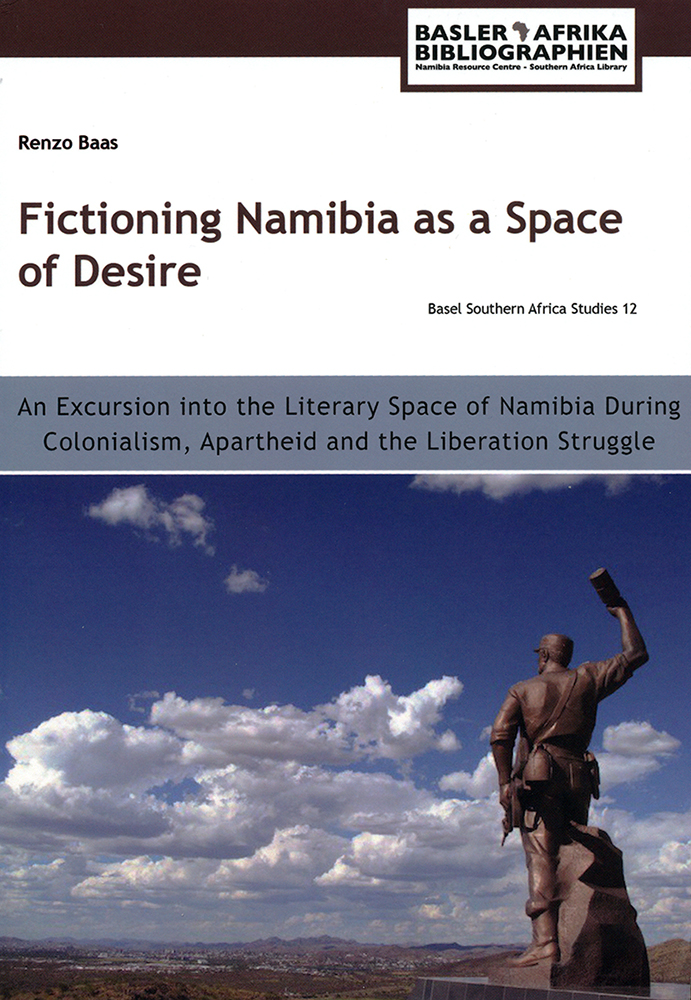Fictioning Namibia as a Space of Desire, by Renzo Baas

Fictioning Namibia as a Space of Desire: An excursion into the literary space of Namibia during colonialism, apartheid and the Liberation Struggle. Basler Afrika Bibliographien. Basel, Switzerland 2019. ISBN 9783906927084 / ISBN 978-3-906927-08-4
Renzo Baas, author of 'Fictioning Namibia as a Space of Desire' is a post-doctoral fellow at the University of KwaZulu-Natal, Durban, where he is working on African-American and African speculative fictions as a response to exclusionary and alienating politics. He has conducted research on (post)colonial literatures, Afrofuturist and African speculative fictions, graphic novels, as well as historic colonial novels.
Introduction to Namibia as a Space of Desire
Then-president of Namibia, Sam Nujoma, declared in his speech at the inauguration of Heroes' Acre in Windhoek in 2005: "we are writing the history of our country from our own perspective and through our own suffering and sacrifices. The time when colonisers distorted our history is now gone forever". This powerful assertion of writing one's own history is a strong reflection of postcolonial moments in which time and space are reconfigured to reflect local temporal and spatial regimes. These regimes, violently reshaped in order to serve European expansionist and imperialist ambitions, are being reactivated in a number of contexts. In Namibia, for example, this has taken the form of a national and symbolic cemetery. Included in the cemetery are a number of anti-colonial as well as anti-apartheid leaders and personalities taken from the larger Namibian societies of the Nama, the Herero, and the Owambo. Symbolic graves of elites such as the Nama kaptein Hendrik Witbooi, Herero omuhona Samuel Maharero, and the Kwanyama king, Mandume Ndemufayo, amongst others, are to be found within the bounds of the Acre. A larger-than-life statue of the "Unnamed Soldier" involved in the liberation struggle and armed with gun and grenade stands watch over these historic Namibian personalities. The incorporation of non-elites also speaks to the involvement of ordinary Namibians in the efforts for independence and self-rule, as the inclusion of Kakurukaze Mungunda exemplifies. Heroes' Acre thus amalgamates various communities, historical eras, and persons of different socio-cultural standing. Heroes' Acre signifies a unified effort for self-governance, evident through the collection of a number of relevant personalities who each fought for this right. The sizable tract of land set aside for this monument outside of Windhoek is testament to the Namibian government's efforts to honour and maintain the memory of those who gave their lives in the pursuit of a life free from the terrors which foreign rule inflicted. The echoes of these sacrifices are palpable today still, when one considers the genocide committed against the Herero and Nama by the German colonial forces, one of the most defining moments in Namibian history and a moment that stretches from 1904 into the present. The Old Location shooting (1959) as well as the Cassinga massacre (1978) by the South African administration under the flag of apartheid are further traumas of which the graves are a painful reminder. President Nujomas declaration, the graves, and their production of a national narrative of resistance powerfully link the independent Namibian state to its violent past.
Producing Certain Spaces
The reworking of this violent past through the combination of the speech and the monument opens up questions concerning the state production of space and the subsequent formation of a memory and hero cult. This is first noticeable when one looks at the location of Heroes' Acre. Situated outside of Windhoek, it lies centrally within Namibia. More importantly, it is incorporated within the limits of the city of Windhoek (Namibia's capital since its 'founding' by Curt von Francois in 18905), but lies outside of its urban core. Windhoek's history points to its fluctuating status, as it was already a centre of commerce and contention before the arrival of the German colonial regime. It later lost some of its renown to other capitals' such as Hornkranz (Witbooi), Okahandja (traditional seat of the Herero elites), and Walvis Bay (as a centre of trade with the Cape Colony). [...]
This is an excerpt from Fictioning Namibia as a Space of Desire, by Renzo Baas.
Title: Fictioning Namibia as a Space of Desire
Subtitle: An excursion into the literary space of Namibia during colonialism, apartheid and the Liberation Struggle
Author: Renzo Baas
Series: Basel Southern Africa Studies 12
Publisher: Basler Afrika Bibliographien
Basel, Switzerland 2019
ISBN 9783906927084 / ISBN 978-3-906927-08-4
Softcover, 17 x 24 cm, 286 pages
Baas, Renzo im Namibiana-Buchangebot
Fictioning Namibia as a Space of Desire
Fictioning Namibia as a Space of Desire: An excursion into the literary space of Namibia during colonialism, apartheid and the Liberation Struggle.

